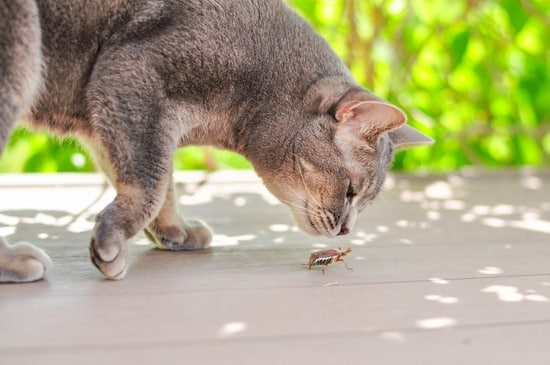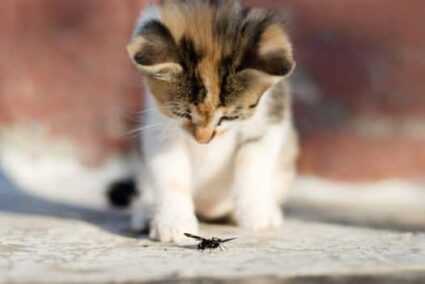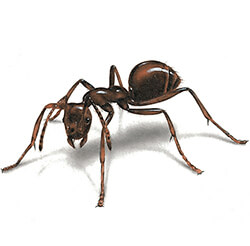Cats are obligate omnivores, which means their main source of nutrition comes from animal protein. Cats are also hunters, and in the wild, they hunt and eat their prey. Their prey usually includes smaller mammals, birds, and fish. But you’ve probably also seen your cat stalk and hunt down insects, and that’ ss left you wondering, do cats eat insects?
Cats do not usually hunt down and eat insects to fill their bellies (with protein). Rather, they seem to do it for fun and because of their instinct. Being the hunters that they are, they have very sharp senses. They can pick up on the slightest of sounds and see the finest of things. So, when they see an insect, even the laziest of cats will have the instinct, which will lead them to stalk, chase, kill, and eat bugs. And sometimes, they do not eat the insects immediately. The poor critter will become a play tool for your cat, who will play with/torture the insect to death.
But as cat owners, we worry about their health all the time. It ‘ss bad enough when our pets get sick, but it’s even worse with cats who manage to hide their pain very well, and their symptoms are often overlooked. This is why when we see how cats chase insects, we would rather be safe than sorry and arm ourselves with the knowledge about which insects are safe for our cats to consume and which ones we should keep our felines far away from.
The Safe Insects ( and some of their species that are not safe):

Spiders
Spiders are insects on the safe side. Well, most of them are. The acids in your cat’s stomach can neutralize the venom that might be present in these eight-legged critters. So, if your cat ends up munching on a spider, they’ll be safe.
However, certain species of spiders might be poisonous for our felines, and these include the Black Widow, Hobo, Brown Recluse, Whitetail, and Hourglass spiders. A bite from these spiders can lead to local necrosis, which can lead to eventual death.
Symptoms of a bite from these species include soreness and itchiness, followed by fever, nausea, weakness, rash, and chills. The bite may become worse if your cat keeps licking the bite. Make sure to seek out your vet in case of a bite.
House Flies and Cuterebra larvae
As pesky as house flies can be, they are the best” “to” your cat can have. They stimulate your cat ‘ss senses and give them a good chase. If your cat does manage to catch them and eat them, your two don’t suffer any health issues as a result.
However, the Cuterebra bot fly is dangerous to your cat, and this has less to do with your cat eating them than it does with them coming in contact with your cat. If the fly gets into contact with your cat, they might lay eggs on them, and once the eggs hatch, the larvae make themselves at home under your pet’s skin and will have to be removed. You’ll have to have a skilled vet remove the eggs since they can get ruptured if you try it yourself.
Cockroaches

Much to our disgust, cats do, on occasion, eat these icky roaches and other insects with hard bodies such as crickets, beetles, and grasshoppers. Typically, these insects are harmless to your feline friends, but there might be gastrointestinal issues from eating the exoskeletons of these insects.
Caterpillars, moths, and butterflies
These insects are pretty much harmless to your furry felines. Since these insects fly, they are all that more tempting to your cats, but you have nothing to worry about. The most harm they can do is if a caterpillar stings your cat, but that is rarely toxic or dangerous for your cat.
However, it is to be noted that larger and exotic moths and caterpillars, such as the Garden Tiger Moth/Caterpillar, can be toxic to your cat if ingested.
Centipedes
![8 Most Dangerous Centipedes [Scolopendridae, Scolopendra cingulata, Amazonian giant centipede]](https://petschoolclassroom.com/wp-content/uploads/2021/06/43_1-Dangerous-Centipedes.jpg)
Another branch of creepy crawlies that you don’t mind your cat ridding your house off. To make things better, most of the common centipedes found in our houses are as harmless as they get. However, the largest ones have venom, which is released when they bite their victim, which in this case, is your cat. It can either cause a localized reaction or lead to a severe response with weakness and fever and an eventual vet visit.
Some species, such as the Texas Redheaded or the Giant Redheaded centipedes, are hazardous and toxic to your cat, but fortunately, you don’t find them in your homes.
Ants

These common insects are pretty much harmless to our fur friends. Most large ones can bite our cats, but the bites pose no harm to our furballs. However, it is the fire ants that need to be kept an eye on. Just like a fire ant bite can be painful for us humans, it is hazardous for cats, and not only are the venomous bites painful, they can also cause severe allergies that can lead to anaphylaxis.
So, if you’ve spotted fire ants around where your cat has been, it is best to take a trip to the vets to rule out any possible health scares.
Lighting Bugs
These bugs are a problem for our cats. If your cat manages to get their paws on these bugs and eats them, it will likely end up with an upset tummy or digestive system. This is because lightning bugs create a bitter chemical called Luci bufagins, which is harmful to your cat’s health.
Conclusion:
It is always a good idea to keep an eye out on your cats to see what they are getting their paws on to keep them safe from potential hazards to their health and to be able to take quick action when needed.